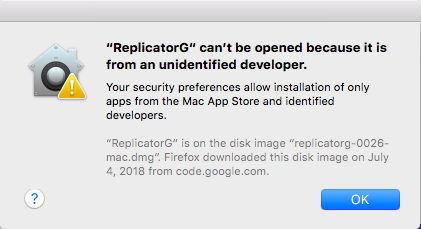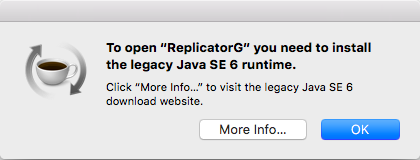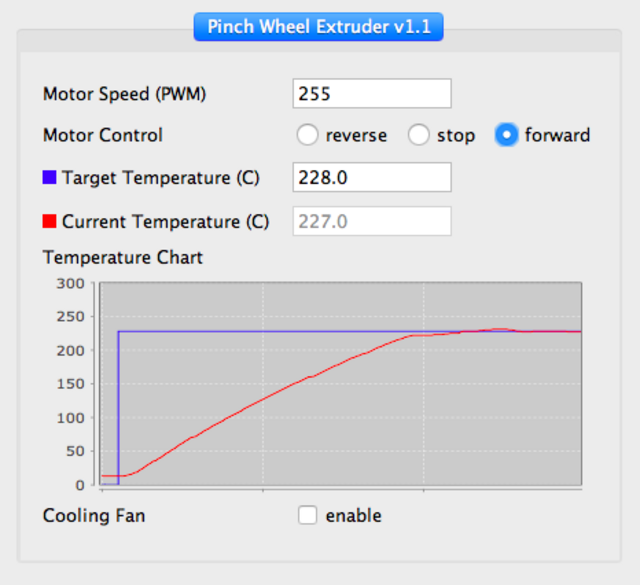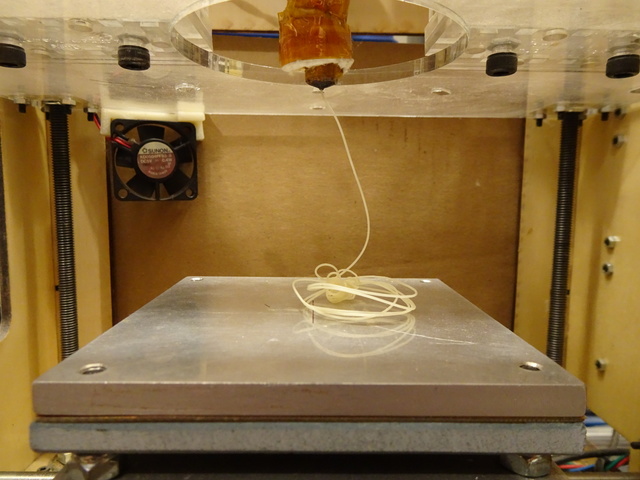The next step in running the CupCake 3D printer is reinstalling the software and connecting to the machine.
It went surprisingly well, with the only real snag being my misremembering the installation process, leaving me stuck in NotConnectedLand for a while.
What Software
A lot has happened in the world of hobbyist 3D printing since the last time I had the CupCake powered up and both new firmware and new driver software are available. I’m interested in upgrading both as I have time; but for a first boot, I want to change as few variables as possible. That means leaving the firmware that’s on the CupCake and matching a legacy version of ReplicatorG to what’s on it. And I had no idea what was on it.
Fortunately I have a blog and on that blog I write some things.
I went to my own blog’s MakerBot CupCake blog category and quickly found the January 2012 post on rebuilding the heater in which I had written:
… I upgraded ReplicatorG from 0024 to 0029r2, and let it upgrade my firmware from v2.4 (I think) to v3.0, and lo! lost communication between ReplicatorG and the CupCake…
This is apparently a known problem …
Anyway, downgrading ReplicatorG to 0026 restored my connectivity …
So there you have it: I need ReplicatorG version 0026 to connect to the 3.0 firmware currently on my CupCake.
Happily, the ReplicatorG web site is still online in spite of MakerBot’s acquisition by Stratasys (though I note there have been no code updates since the acquisition). The download page has dowload links for only the last version (0040) but also has links to the Google Code archive, which on p3 has that 0026 for the Mac that I’m looking for.
Running ReplicatorG
I downloaded ReplicatorG 0026 and tried running it from the disk image before actually installing it on my laptop. I got the standard security warning:
and had to look up to right-click and Open rather than double-click and change security preferences. After much playing around yesterday, I see that OS X Sierra does not remember approval I’ve given to run software on a disk image but does remember approval I’ve given to run software once it’s installed.
Once I got past that, I got a Java version error:
Shockingly, clicking More Info... in that dialog does something useful — it takes me to Apple’s JRE download page for that version. After regaining consciousness, I installed that software and ReplicatorG starts up like a champ.
Can’t Connect to the CupCake (Because I Installed ReplicatorG Wrong)
It doesn’t appear to see the CupCake, though,
giving the error:
Could not load machine 'null' no machineNode found
could not load machine 'null' please check Driver-> <Machine Name>
It does see my FTDI USB-serial cable under Machine / Serial Port. It does not have anything listed under Machine / Driver and it does not bring up anything when I select Machine / Machine Information…
I don’t find much online about this. A Thingiverse Sailfish firmware comment sounds as though I simply have the wrong machine type selected, but I can’t even select a machine type. The tail end of a ReplicatorG comment thread sounds as though it can’t see USB-serial ports on current OS X versions, but it does see it. A much older MakerBot forum post mentions success after reseating the FTDI cable; but I don’t even know whether that’s the same issue and reseating mine didn’t help.
Installing ReplicatorG Correctly
It seemed obviously wrong that I couldn’t bring up the Machine Information… dialog, and I hunched that something was wrong there. Researching about the machine type, I saw that the ReplicatorG machine configuration page mentions a machines.xml file, which I didn’t have. But that sparked a memory — the ReplicatorG disk image had a machines folder in it and … oh, yeah.
The ReplicatorG Mac installation page clearly says to create a ReplicatorG folder under Applications and drag the entire contents of the ReplicatorG disk image into it. Which I hadn’t. I’d just dragged the app because in spite of remembering and knowing better, I’d just dragged the app.
I deleted the app from Applications, created the folder, dragged the contents, started ReplicatorG by right-clicking and choosing Open, and boom. Connected to the CupCake.
First Extrusion
I went back to my same blog post and found the nozzle temperature that works well for my CupCake, then set that and ran the extruder:
I don’t have any of my CupCake’s calibration settings loaded in yet, in particular my thermistor coefficients, so this temperature is only an estimate; but it worked well enough.
First squeeze! Software installed; connected to and controlling the machine.
A Brief Aside About the FTDI USB-Serial Driver
When first I ran the ReplicatorG software, I wondered whether I had the FTDI USB-Serial driver already loaded on my MacBook from working with Arduino or whether the driver was missing and was the cause of the problem. ReplicatorG did find a USB-Serial under the Serial Port list, but I still questioned.
A bit of research shows that the driver’s presence or absence can be seen by running System Information and looking under Software / Installations. I didn’t see it there and I found that it can also be checked by running pkgutil --pkgs | grep -i ftdi . Didn’t see it there either.
The FTDI driver version supplied with ReplicatorG was of course quite old and I didn’t know how well it’d work on a newer OS X release. I went to FTDI’s Virtual Com Port (VCP) driver page, downloaded and installed version 2.4.2, and found that it made no changes to what I was experiencing. I’m wondering whether the FTDI driver is by now supplied as part of OS X or whether it silently installed when I installed the Arduino software on this MacBook.





